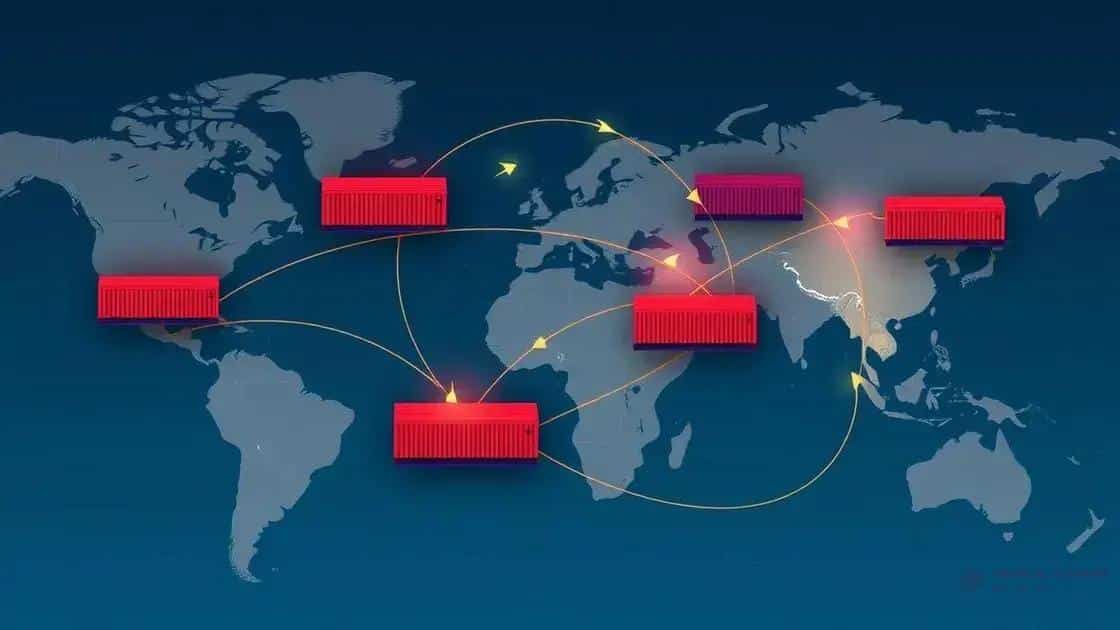Financial repercussions of the US-China trade conflict

The financial repercussions of the US-China trade conflict significantly disrupt global markets, impacting US manufacturers and Chinese exports while prompting shifts in international trade practices and alliances.
The financial repercussions of the US-China trade conflict are felt around the globe. But have you ever considered how these tensions might directly affect your daily life or business decisions?
Overview of the US-China trade conflict
The US-China trade conflict has been a significant issue affecting economies worldwide. This conflict started around 2018 and has led to various tariffs and trade barriers. Understanding its background and consequences is essential for grasping its wide-ranging effects.
Historical Cntext
The trade relationship between the US and China has been complex, dating back several decades. Initially, China’s entry into the World Trade Organization (WTO) in 2001 was seen as a stepping stone towards a more open market. However, tensions began to rise when the US accused China of unfair trade practices.
Key Factors of the Conflict
- Trade Imbalance: The US has a significant trade deficit with China, prompting concerns over job losses.
- Intellectual Property Theft: Accusations of Chinese firms stealing US intellectual property have fueled tensions.
- Tariffs: The imposition of tariffs on hundreds of billions of dollars’ worth of goods has escalated the situation.
As tariffs increased, businesses on both sides faced higher costs. For example, American farmers struggled to export their goods, while Chinese consumers dealt with rising prices on US imports. This back-and-forth has affected global supply chains, with many companies reevaluating their production strategies.
Moreover, the financial repercussions extend beyond just the US and China. Countries that rely on trade with either nation have felt the sting of these tariffs as well. Consequently, many are now seeking alternative markets or negotiating new trade agreements.
Potential Future Developments
Looking ahead, the US-China trade conflict could change the dynamics of global trade. As both nations reassess their strategies, the focus may shift towards negotiations for a more balanced trade relationship.
Economic impact on US manufacturers

The economic impact on US manufacturers due to the trade conflict with China has been significant and complex. As tariffs were implemented, many manufacturers found themselves facing new challenges that affected their bottom line and operational strategies.
Increased Costs of Production
Manufacturers in the US have experienced rising costs for raw materials due to tariffs imposed on goods imported from China. This situation has forced many companies to either absorb these costs or pass them on to consumers. For instance, industries such as steel and aluminum were heavily impacted, as prices surged, leading to higher expenses.
Supply Chain Disruptions
The ongoing conflict has disrupted global supply chains, making it harder for US manufacturers to source materials efficiently. Companies have been compelled to explore alternative suppliers or consider relocating their manufacturing to countries outside China.
- Immediate Challenges: Many companies faced delays in shipments, causing production schedules to be disrupted.
- Long-Term Changes: Some manufacturers are now looking to diversify their supply chains to reduce dependency on China.
- Investment in Automation: To minimize the impact of rising costs, manufacturers are increasing investments in automation and technology.
This shift towards automation is also seen as a necessity to remain competitive. Manufacturers who adapt quickly can mitigate the adverse effects of the trade conflict. Furthermore, they may find new opportunities in the changing landscape of global trade.
With these ongoing challenges, the future for US manufacturers is uncertain. They will need to be agile in their strategies to navigate the evolving market conditions influenced by the US-China trade conflict.
Effects on Chinese exports and imports
The effects on Chinese exports and imports resulting from the US-China trade conflict have been profound and significant. As the trade war unfolded, various sectors in China faced new challenges that impacted their economic stability.
Decline in Exports
One of the most noticeable effects has been the decline in exports from China to the US. Many Chinese manufacturers, particularly in industries such as electronics and textiles, relied heavily on the US market. With increased tariffs, their products became more expensive for American consumers, leading to a decrease in demand.
Shifts in Trade Patterns
This situation has prompted China to seek alternative markets for its goods. Countries in Southeast Asia, Europe, and Africa have become new targets for Chinese exports. Additionally, some businesses have started to adapt their strategies by producing goods that cater to local markets instead.
- Increased Trade with Other Countries: China’s trade with countries like Vietnam and India has surged as it seeks to diversify its export markets.
- Import Adjustments: In response to the tariffs, China has also adjusted its import policies. This includes sourcing products from countries not affected by tariffs.
- Investment in Domestic Industries: The Chinese government has encouraged investment in local industries to reduce dependency on foreign imports.
As a result, the landscape of international trade for China is shifting. Businesses are increasingly looking at building resilience against future trade conflicts by diversifying their supply chains. In doing so, they aim to offset potential losses inflicted by tariffs and manage risks effectively.
The long-term effects of these changes remain to be seen, but the current trajectory suggests a significant transformation in China’s approach to exports and imports.
Impact on global supply chains

The impact on global supply chains due to the US-China trade conflict is far-reaching and complex. As tariffs have increased, many companies have had to reassess their sourcing and manufacturing strategies.
Disruption of Existing Relationships
Many businesses that relied on Chinese suppliers for raw materials and components have faced significant disruptions. This has led to delays in production and increased costs. With the trade war in full effect, companies are rethinking their long-term partnerships.
Shift in Manufacturing Locations
As a response to these disruptions, many manufacturers are shifting their production away from China. Countries in Southeast Asia, such as Vietnam and Thailand, are increasingly becoming alternatives. This move helps companies avoid tariffs imposed by the US and minimizes risks associated with relying on a single country.
- Increased Diversification: Companies are now looking to diversify their supply chains to include multiple countries.
- Resilience in Supply Chains: Strengthening supply chains to withstand future disruptions has become a key focus.
- Adoption of New Technologies: Businesses are investing in technologies to improve supply chain efficiency and visibility.
The shift away from traditional sourcing strategies means that many businesses are now considering nearshoring options. This involves moving production closer to the end consumer. By doing so, companies aim to reduce lead times and enhance flexibility in their operations.
Ultimately, the US-China trade conflict has ignited a reevaluation of global supply chains. Companies that adapt quickly may find opportunities to streamline operations and gain a competitive edge in the ever-changing global market.
Future implications for international trade
The future implications for international trade are shaping up to be significantly impacted by the ongoing US-China trade conflict. As countries reassess their trading relationships, new strategies are forming to navigate this complex landscape.
Emerging Trade Alliances
With tensions between the US and China, many nations are starting to form new trade alliances. Countries are seeking opportunities to collaborate more closely, especially those that may have been overlooked in the past. For instance, nations in Asia and Africa are looking to strengthen their economic ties to create a more interconnected market.
Changes in Trade Policies
The conflict has prompted governments to rethink their trade policies. Tariff strategies and trade agreements are under review, leading to adjustments that could better protect local industries. This shift may encourage countries to adopt more protective economic measures to safeguard their markets from external pressures.
- Increased Focus on Innovation: Countries might invest more in technology and innovation to boost their competitive advantage.
- Emphasis on Sustainability: Future trade agreements may include environmental standards to address climate change.
- Resilient Supply Chains: There’s a push toward building resilient supply chains to withstand future disruptions.
The way businesses operate globally will evolve in response to these changes. Companies must remain agile and adaptable to new trade regulations and market demands. This adaptability will be crucial for maintaining competitive advantages in an unpredictable global market.
Furthermore, as international relationships shift, businesses will need to engage with diverse markets. Understanding local regulations and consumer preferences will be essential for successful global operations. The future of international trade holds both challenges and opportunities, and staying informed will be key to thriving in this new environment.
FAQ – Frequently Asked Questions about the US-China Trade Conflict
What is the main cause of the US-China trade conflict?
The main cause of the US-China trade conflict is the trade imbalance between the two countries, along with accusations of unfair trade practices and intellectual property theft.
How have US manufacturers been affected by the trade conflict?
US manufacturers have faced increased costs due to tariffs and supply chain disruptions, forcing them to rethink their sourcing and production strategies.
What impact does the trade conflict have on global supply chains?
The trade conflict has disrupted global supply chains, leading many businesses to diversify suppliers and consider new manufacturing locations to avoid tariffs.
What are the future implications for international trade?
Future implications include the formation of new trade alliances, changes in trade policies, and a greater focus on resilience and sustainability in global trade practices.





